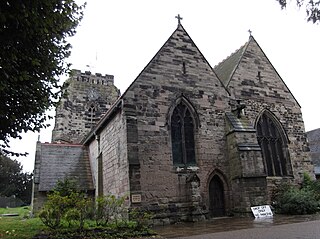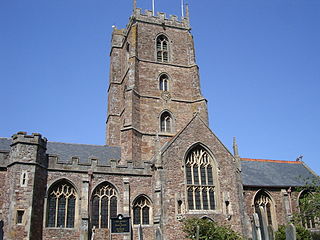
Deeping St James Priory was a priory in Deeping St James, Lincolnshire, England. It was a dependency of Thorney Abbey.

Deeping St James Priory was a priory in Deeping St James, Lincolnshire, England. It was a dependency of Thorney Abbey.
In 1139 Baldwin Fitz Gilbert established the Benedictine Priory of Saint James at Deeping as a cell of Thorney Abbey. [1] The endowment of the priory consisted of the two churches of Deeping, St James and St Guthlac. While Thorney Abbey appointed the priest and supervised the administration of the Priory, the church was still the parish church of the local villagers. [2]
The cell was dissolved at the surrender of Thorney in 1539. [3] [4] The priory church remains as the Church of England parish church of Deeping St James and is a Grade I listed building. [5]
On the south-east side of the churchyard was the priory tithe barn, which measured 90 feet by 20 feet, 6 inches internally. It has variously been described as 13th century, late 15th century, or 17th century. It was demolished in 1963. [1]
There are no surface indications or remains of the monastic house. [1]
The church contained an organ dating from 1902 by Abbot & Smith; a specification can be found on the National Pipe Organ Register. [6]

The list of known names is incomplete: [3]

The Abbey Church of Saint Peter and Saint Paul, commonly known as Bath Abbey, is a parish church of the Church of England and former Benedictine monastery in Bath, Somerset, England. Founded in the 7th century, it was reorganised in the 10th century and rebuilt in the 12th and 16th centuries; major restoration work was carried out by Sir George Gilbert Scott in the 1860s. It is one of the largest examples of Perpendicular Gothic architecture in the West Country. The medieval abbey church served as a sometime cathedral of a bishop. After long contention between churchmen in Bath and Wells the seat of the Diocese of Bath and Wells was later consolidated at Wells Cathedral. The Benedictine community was dissolved in 1539 during the Dissolution of the Monasteries.

Wymondham Abbey is the Anglican parish church for the town of Wymondham in Norfolk, England.

Malmesbury Abbey, at Malmesbury in Wiltshire, England, is a former Benedictine abbey dedicated to Saint Peter and Saint Paul. It was one of the few English religious houses with a continuous history from the 7th century through to the Dissolution of the Monasteries.

Polesworth Abbey was a Benedictine nunnery in Polesworth, North Warwickshire, England.

Deeping St James is a large village in the South Kesteven district of Lincolnshire, England. The population of the civil parish was reported as 7,051 at the 2011 census.

Crowland Abbey is a Church of England parish church, formerly part of a Benedictine abbey church, in Crowland in the English county of Lincolnshire. It is a Grade I listed building.

Thorney Abbey, now the Church of St Mary and St Botolph, was a medieval English Benedictine monastery at Thorney, Cambridgeshire in The Fens of Cambridgeshire, United Kingdom

Isleham Priory Church, located in Isleham, Cambridgeshire, England, is a Benedictine alien priory built around 1100 AD. It is an important example of an early 12th-century Norman church. Despite being converted into a barn after the Reformation, the building remains mostly in its original state. The church is designated a Grade I listed building. The structure and surrounding area are also designated a scheduled Ancient Monument.

Bardney Abbey in Lincolnshire, England, was a Benedictine monastery founded in 697 by King Æthelred of Mercia, who was to become the first abbot. The monastery was supposedly destroyed during a Danish raid in 869. In 1087, the site was refounded as a priory, by Gilbert de Gant, Earl of Lincoln, and it regained status as an abbey in 1115.

The Priory Church of St Mary, Abergavenny is a parish church in the centre of Abergavenny in Monmouthshire, Wales.

Lancaster Priory, formally the Priory Church of St Mary, is the Church of England parish church of the city of Lancaster, Lancashire, England. It is located near Lancaster Castle and since 1953 has been designated a Grade I listed building. It is in the deanery of Lancaster, the archdeaconry of Lancaster and the Diocese of Blackburn. Its benefice is combined with that of St John and St Anne.

Hatfield Broad Oak Priory, or Hatfield Regis Priory, is a former Benedictine priory in Hatfield Broad Oak, Essex, England. Founded by 1139, it was dissolved in 1536 as part of Henry VIII's dissolution of the monasteries.

The Parish and Priory Church of St Mary is located in Chepstow, Monmouthshire, south east Wales. Parts of the building, including its ornate west doorway, date from the late 11th century and are contemporary with the nearby Norman castle. The church is a Grade I listed building.

Dunster Priory was established as a Benedictine monastery around 1100 in Dunster, Somerset, England.

St Mary Magdalene was a Benedictine priory in Lincoln, England. Along with Sandtoft Priory and Hanes Cell, it was a Lincolnshire cell of St Mary's Abbey in York, England. A surviving building, once owned by the priory, is Monks' Abbey, Lincoln.

St Mary the Virgin's Church is a former priory church in the village of Bromfield, Shropshire, England. It is an active Anglican parish church in the deanery of Ludlow, the archdeaconry of Ludlow, and the diocese of Hereford. Its benefice is united with those of 5 other parishes to form the Bromfield Benefice. The church is recorded in the National Heritage List for England as a designated Grade I listed building.

St Margaret's Church, King's Lynn, entitled King's Lynn Minster since 2011, is a Grade I listed parish church in the Church of England in King's Lynn. The building dates from the 12th to 15th centuries, with major restoration of the nave in the 18th century. Five of its ten bells and its organ also date back to the mid-18th century.

Holy Trinity Church, Micklegate, York is a Grade I listed parish church in the Church of England in York.